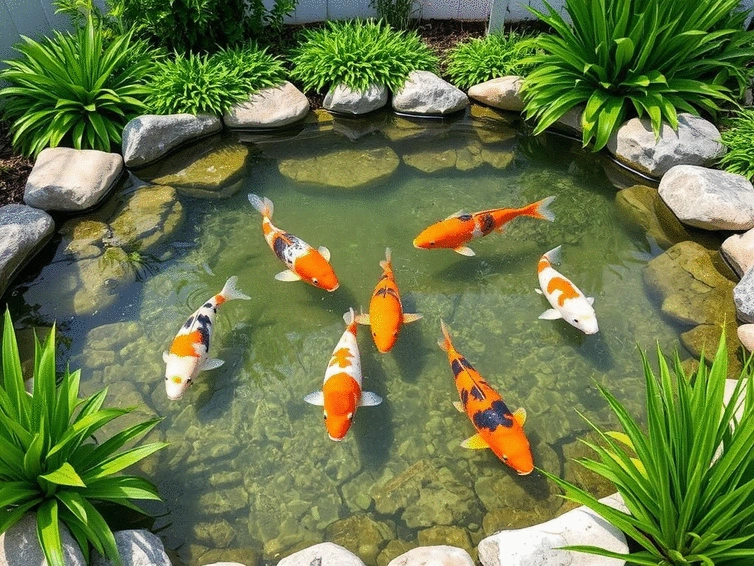
Koi Pond Construction for Beginners
Building a koi pond can transform your outdoor space into a serene sanctuary. Discover the essential insights that will guide you through this rewarding journey!
What You Will Learn
- Koi ponds enhance garden aesthetics, creating a tranquil focal point that attracts wildlife and promotes relaxation.
- Misconceptions about koi pond maintenance being overly difficult are common; with proper resources, it’s manageable for beginners.
- Selecting the right location for your pond is crucial for accessibility, visibility, and the health of your koi.
- Incorporating natural elements like rocks and plants in your pond design enhances both beauty and functionality.
- A minimum depth of 3-5 feet is essential for koi health, helping regulate temperature and offering protection from predators.
Optimal Koi Pond Planning & Design Considerations
Building a successful koi pond involves key decisions regarding location and design. Here’s a breakdown of essential factors to ensure a thriving aquatic environment.
1Location Essentials
- Sunlight: 6 hours daily for koi health.
- Trees: At least 10 feet away to prevent debris.
- Accessibility: Easy access for maintenance.
2Pond Depth & Design
- Shallow: 1-2 ft (plants, sun).
- Mid-depth: 3-4 ft (koi swimming).
- Deep: 5+ ft (winter, predator protection).
3Key Benefits
- Beauty: Enhances garden aesthetics.
- Ecosystem: Attracts diverse wildlife.
- Well-being: Stress relief and educational value.
4Misconceptions Debunked
- Maintenance: Manageable with resources.
- Expertise: DIY-friendly with guidance.
- Size: Suitable for various garden sizes.
Understanding Koi Pond Construction for Beginners
As a koi pond enthusiast, I can tell you that building your own koi pond is not just a project; it’s a transformative experience! Creating a vibrant aquatic sanctuary right in your backyard can provide numerous benefits, both for you and your garden. In this section, we’ll explore the many reasons to build a koi pond and address some common misconceptions that may hold you back from diving into this rewarding hobby.
Why Build a Koi Pond? Benefits for Your Garden
There are plenty of reasons to consider adding a koi pond to your outdoor space. Here are just a few of the benefits:
- Natural Beauty: A koi pond enhances the aesthetic of your garden, creating a serene focal point that draws the eye and adds tranquility.
- Wildlife Habitat: Your pond can attract various wildlife, including birds and beneficial insects, contributing to a healthier ecosystem.
- Stress Relief: The soothing sounds of water and the sight of koi swimming can significantly reduce stress, making it a perfect retreat.
- Educational Opportunities: For families, a koi pond provides a wonderful way to teach children about nature, ecosystems, and responsibility.
Each of these benefits contributes to a more significant sense of well-being and joy in your outdoor living space. Are you starting to see how a koi pond could enhance your life?
Common Misconceptions About Koi Ponds
Many people shy away from building a koi pond due to misconceptions. Let’s clear some of these up:
- Koi Ponds Are Too Difficult to Maintain: While they require regular care, I assure you that with determination and the right resources, maintenance can be manageable!
- Only Experts Can Build Them: You don’t need to be a professional to create a beautiful koi pond. With some planning and our comprehensive guides at Best Koi Ponds, you can do it yourself!
- They Are Only for Large Yards: Koi ponds come in various sizes, making them suitable for even small spaces.
By addressing these misconceptions, I hope to inspire you to consider building your own koi pond. It’s truly a fulfilling journey!
Planning Your Koi Pond: Key Considerations
Before diving into construction, the planning phase is crucial to ensure your pond aligns with your vision and the needs of your koi. Let’s discuss the key considerations to take into account, starting with the right location.
Choosing the Right Location for Your Koi Pond
The location of your koi pond will significantly impact its health and the overall enjoyment it brings. Here are some factors to think about:
- Accessibility: Ensure the pond is easy to access for maintenance and viewing.
- Visibility: Position it where you can easily enjoy the view from your home or patio.
- Safety: Consider the safety of pets and children when selecting a location.
With these points in mind, you can start envisioning the ideal spot for your new aquatic haven!
Sunlight and Shade Requirements
One of the most important aspects of your pond's location is its sunlight exposure. Koi thrive in sunny areas but also need some shade to avoid overheating. Ideally, your pond should receive around 6 hours of sunlight while having shaded areas for your koi to retreat during the hottest parts of the day. This balance will help maintain a healthy environment for your fish. For more detailed information on pond construction, you can refer to the New York State Department of Environmental Conservation's guide on pond construction.
Proximity to Trees and Plants
While trees add beauty, they're not always your pond's best friend! Fallen leaves and debris can clog filters and degrade water quality. It’s wise to place your pond away from heavy tree cover to minimize maintenance while still considering nearby plants that can enhance your pond's aesthetics. For beginners looking for guidance, Oklahoma State University Extension offers valuable insights into building a koi pond.
Designing Your Koi Pond: Aesthetic and Functional Elements
Now that you’ve chosen a location, let’s move on to the fun part—designing your koi pond! A well-thought-out design not only boosts aesthetics but also ensures functionality.
- Visual Appeal: Think about incorporating natural features like rocks and plants into your design.
- Practical Dimensions: Consider the size and depth of the pond to ensure it meets the needs of your koi.
- Water Flow: Design the pond layout to facilitate water circulation, essential for the health of your fish.
Designing your pond should be a creative and enjoyable process, allowing you to express your personality while creating a stunning feature for your garden.
Incorporating Natural Features for Better Aesthetics
Adding elements like rocks, gravel, and aquatic plants can greatly enhance your pond's beauty! These features not only look great but also provide shelter and breeding grounds for your koi. I recommend considering the natural surroundings of your garden to create a seamless connection between your pond and the landscape.
Planning for Depth and Shape of the Pond
The shape of your koi pond can vary based on your garden’s layout, but depth is crucial for the health of your fish. A minimum depth of 3-4 feet is recommended to ensure your koi are safe from temperature extremes and predators. Additionally, varying the depths can create interest and provide different habitats within the pond.
Understanding Pond Depth Calculation for Koi Health
When planning your pond’s depth, remember that koi need space to swim freely and grow. Ensure you calculate the volume correctly, as this affects water quality and filtration. For instance, a deeper pond can better regulate temperature and provide a more stable environment for your fish. Michigan State University provides an excellent guide on how to build a koi pond for beginners, which includes practical advice on depth and other critical aspects.
Frequently Asked Questions (FAQs)
Here are some common questions about building and maintaining a koi pond:
- How deep should a koi pond be? A minimum depth of 3-5 feet is recommended for koi health, providing protection from temperature extremes and predators.
- How much sunlight does a koi pond need? Ideally, a koi pond should receive around 6 hours of sunlight daily, with shaded areas for koi to retreat from the hottest parts of the day.
- Can I build a koi pond myself? Yes, with proper planning, resources, and guidance, building a koi pond is manageable for DIY enthusiasts.
- What are the benefits of a koi pond? Koi ponds enhance garden aesthetics, attract wildlife, offer stress relief, and provide educational opportunities.
- How far should a koi pond be from trees? It is wise to place your pond at least 10 feet away from large trees to prevent debris from falling into the pond and roots from interfering with the liner.
Interactive Poll
We'd love to hear from you! What aspect of koi pond construction excites you the most? Select one:
Planning Your Koi Pond: Key Considerations
As I embarked on my journey to create the ultimate koi pond, I quickly realized that planning is the cornerstone of a successful build. It's like laying the foundation of a beautiful work of art—every detail matters! From location to design, each decision contributes to the overall harmony of your aquatic environment.
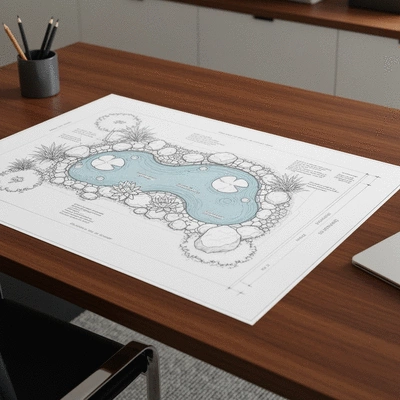
One of the first things to consider is the location of your pond. It’s vital to choose a spot that not only enhances the beauty of your garden but also supports the health of your koi. Let’s dive into a few key considerations you shouldn’t overlook!
Choosing the Right Location for Your Koi Pond
Finding the perfect spot involves a mix of practical and aesthetic choices. Here are some essential factors to consider:
- Sunlight and Shade: Koi thrive in environments with both sunny and shaded areas. Ideally, your pond should receive at least 5-6 hours of sunlight daily, which helps maintain healthy water temperatures.
- Proximity to Trees: While trees can provide shade, their roots and falling leaves can complicate pond maintenance. Aim for a location that is a safe distance from large trees to avoid debris and root interference.
- Accessibility: Consider how easy it will be to maintain your pond. You’ll want it to be easily accessible for feeding your koi and conducting regular maintenance tasks.
In my experience, finding a balance between these factors makes a significant difference in the long-term enjoyment of your koi pond! Remember, the better the placement, the happier your fish will be.
Sunlight and Shade Requirements
When it comes to sunlight, koi need a blend of both light and shade to thrive. Too much sun can lead to excessive algae growth, while too much shade can affect the growth of beneficial plants. I recommend observing your garden throughout the day to determine how sunlight plays on potential pond locations. You might be surprised at how the light shifts!
Key tips for sunlight and shade:
- Monitor the area at different times of day.
- Consider installing shade plants around the pond.
- Ensure that pond depth allows for fish to find cooler spots when needed.
Proximity to Trees and Plants
While trees provide shade and natural beauty, they can also create challenges for pond keepers. Roots can invade your pond, disrupting the liner, and leaves can fall, creating a messy environment. A good rule of thumb is to keep your pond at least 10 feet away from large trees to minimize these issues.
Incorporating plants around your pond can enhance aesthetics and provide natural filtration, but choose wisely! Avoid invasive species that might take over your pond’s ecosystem. A few well-placed shrubs or flowers can create a stunning backdrop while still keeping maintenance manageable.
Designing Your Koi Pond: Aesthetic and Functional Elements
Designing your koi pond should be an exciting process! The aesthetic appeal is just as important as the functionality. Think about how you want your pond to look and how it will fit into your garden. Here are some key elements to consider:
- Natural Features: Incorporating rocks, logs, and plants can create a more natural habitat for your koi.
- Pond Shape: Whether you prefer a natural meandering shape or a sleek rectangular design, your pond's shape should complement your garden's layout.
- Pond Depth: A deeper pond provides stability for your koi and helps maintain optimal water temperatures.
By blending aesthetics with practicality, you'll create a koi pond that becomes a stunning focal point in your garden. My personal favorite is using natural stones to create gentle slopes—this not only looks beautiful but also benefits the fish!
Incorporating Natural Features for Better Aesthetics
Adding natural features enhances both the beauty and health of your pond. Stones and driftwood can serve as hiding spots for koi and create a more dynamic environment. Try placing larger stones around the edges to provide visual interest and help maintain water temperature.
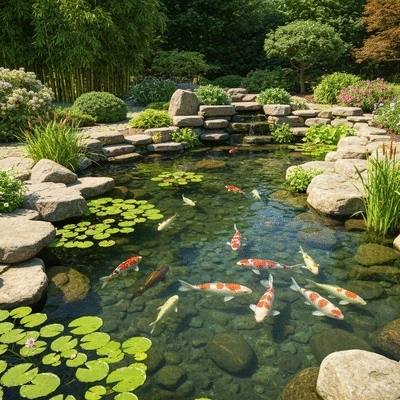
Tips for incorporating natural features:
- Use local stones for a more organic look.
- Position rocks at varying heights to create depth.
- Include plants that thrive in water to attract wildlife and improve water quality.
Planning for Depth and Shape of the Pond
Understanding the ideal depth and shape is critical for koi health. Generally, a depth of at least 3-5 feet is recommended to protect your koi from predators and temperature fluctuations. A well-thought-out shape allows for better circulation of water, which is essential for maintaining quality.
Consider how your chosen shape complements your landscape. A natural, flowing design can blend beautifully with gardens, while geometric shapes can provide a contemporary feel!
Understanding Pond Depth Calculation for Koi Health
Calculating the right depth is a balancing act between aesthetics and koi care. The deeper the pond, the more stable the temperature and environment it provides. As a guideline, the following depths are recommended:
- Shallow areas: 1-2 feet for plants and sunlight.
- Mid-depth: 3-4 feet for koi to swim comfortably.
- Deep areas: 5+ feet for winter survival and protection from predators.
As you can see, planning your koi pond involves more than just digging a hole! Taking the time to consider these factors will help ensure your pond is not only beautiful but also a thriving environment for your koi.
Recap of Key Points
Here is a quick recap of the important points discussed in the article:
- Natural Beauty: A koi pond enhances the aesthetic of your garden, serving as a serene focal point.
- Wildlife Habitat: Your pond can attract various wildlife, contributing to a healthier ecosystem.
- Proper Planning: Choose the right location, considering accessibility, visibility, and sunlight exposure for optimal koi health.
- Incorporating Natural Features: Use rocks and plants to enhance beauty and provide shelter for koi.
- Understanding Depth: Aim for a depth of at least 3-5 feet to protect koi from predators and temperature extremes.

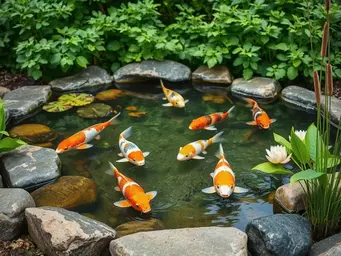
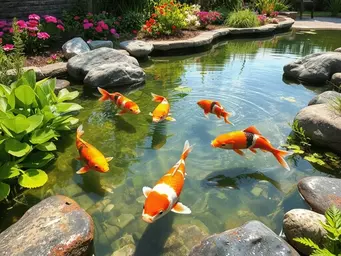
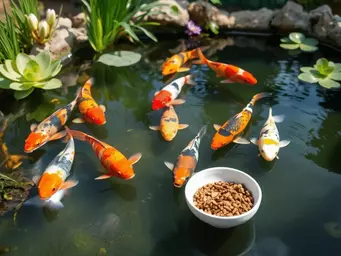
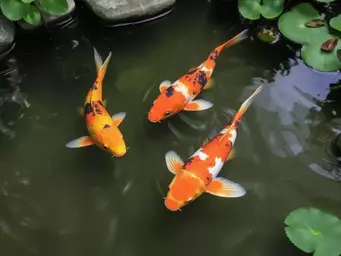
Koi Pond Budgeting Made Simple
Building a Self-Sustaining Koi Pond
Koi Care Tips for Every Season
Managing Koi Pond Chemical Levels
Koi Pond Building Mistakes to Avoid